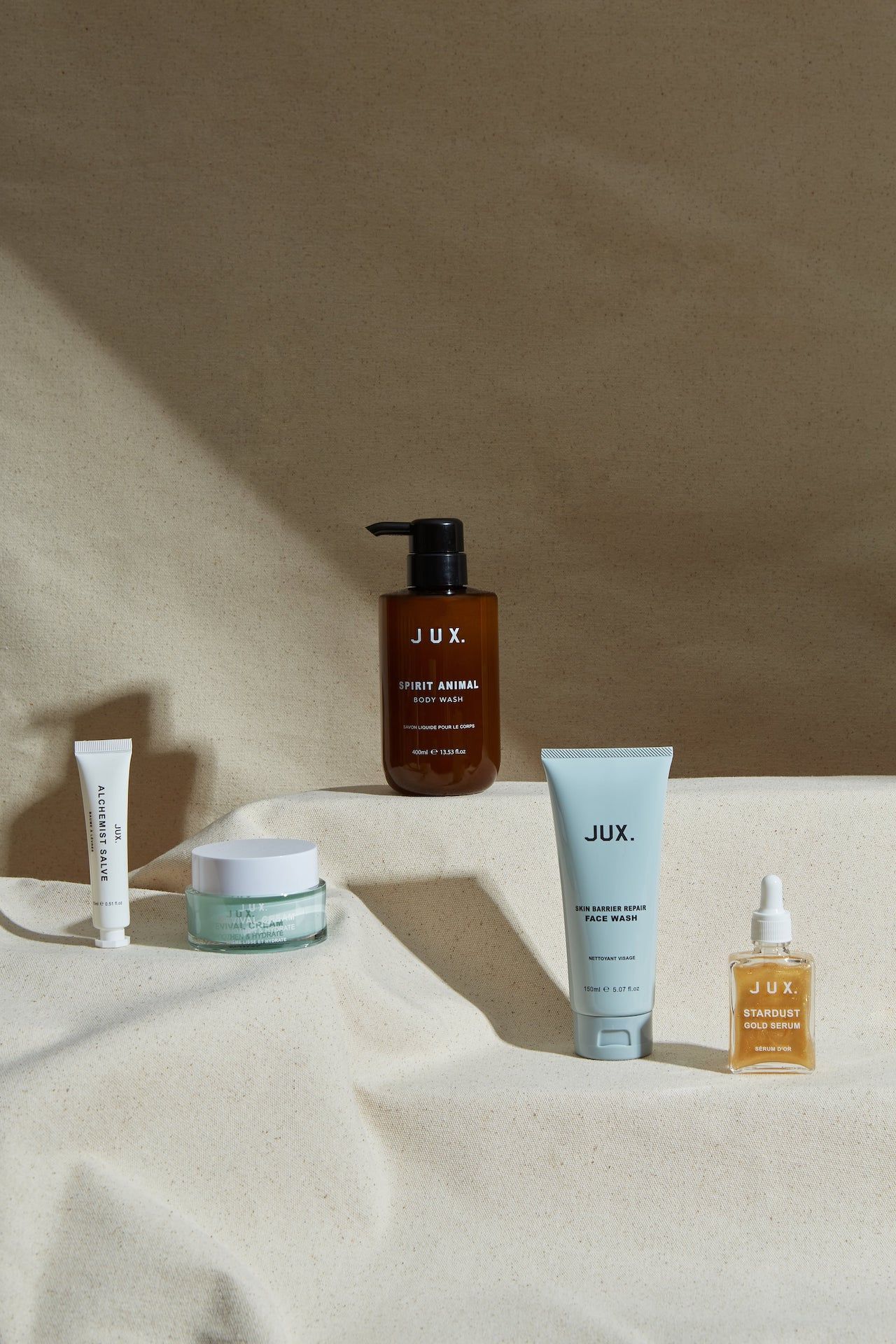Air pollution, extreme weather, and climate change all contribute to the ever-changing landscape we live in today, stressing our mind, body, and skin by the day.
The solutions to these problems are, inevitably, quite complicated. But in this day and age, skincare concerns – and their solutions – have also taken center stage. It’s also not just about fixing our skin problems anymore, and has become so much more than that. What ingredients are in the products? How natural, sustainable, and eco-conscious are they? How transparent is the brand? Is the brand cruelty free?
Maintaining healthy skin is hard, and choosing the right products for your skin – the ones that can withstand the test of weather and time, could be even harder.
Among the wealth of progressive skincare brands out there, there’s a new kid in town that we think you should definitely know about – JUX, a conscious skincare brand that promotes gender-inclusivity and firmly believes in “non-conforming beauty.”
Short for juxtaposed, which means placing two opposing concepts side by side to create a contrasting but unexpected effect, local Thai brand JUX. harnesses the power of nature with science to create the ultimate “hybrid” ingredient that are able to transform stressful skin into healthy skin – against all odds and extremes.
Why? Because as much as nature may seem worlds apart from science, one element cannot exist without the other.

Survival of the fittest
JUX.’s products are inspired by, and derived from life in the extremes, places where only a few life grows – from the driest deserts, deepest oceans, to the glaciers and so forth. We’re talking about extremophytes, or plants and microbes found to have unique molecular structures and molecules that are able to adapt and thrive against the harsh environmental landscapes that they live in.
“Our ingredients may come from nature, but they cannot exist without science,” JUX. positions themselves. Within the DNA of these extremophytes lie the regenerative properties that are not only highly compatible with our skin, but are also able to provide our skin with newfound abilities to regenerate themselves and adapt to today’s ever-changing environments, especially in moments when they cannot produce these properties on their own.
Clean is more
By eliminating over 2,000 toxic ingredients found in the plants, and through years of extensive research and experiments (yes, this is where the science comes into the picture), JUX’s products are born out of meticulously curated, and uniquely engineered formulas that are safe, effective, and indulging for the skin.
JUX. is free of the following chemicals: paraben, SLS, SLES, phthalate, drying alcohols, methylisothiazolinone, styrene, silicones, synthetic colourants, BHT, hydroquinone, insoluble micro-plastic beads, animal oil, and more. They also place great importance on balancing pH levels in their products, as to avoid extreme conditions on the skin.
Not only that, the brand is also vegan-friendly, cruelty free, and sources their bio-based ingredients globally from local communities worldwide. Their packages are recyclable as well.
All of the efforts above echo JUX.’s firm stance on their conscious, progressive, and thoughtful mission to create meaningful products that last and have an impact on the world. Why? Because quality and consumption are more than what meets the eyes, which has led to their brand ethos: #cleanismore.
With that being said, here are some of their hottest debuts that you should definitely check out.
Jump To / Table of Contents
Stardust Gold Serum
Inspired by the desert and concept of “we’re all made of stardust,” this 2-in-1 versatile serum acts both as a hyper-pigmentation corrector and shimmer. The serum, in all its liquid gold, mirage-like glory, contains 14 vitamins, including 24k gold and 4 multivitamins (niacinamide, peptide, mineral complex, and ceramide complex), flowers, and plants powers – just to name a few – to create an evened-out complexion that is as hydrating as it is glowing.
Suitable for all skin types and able to be used for the face and body, you’ll surely “shine like a star.”
Additional Information
This face cream that serves as a luminous, luxurious, and fast-absorbing moisturiser is inspired by the harsh and cold weather of winter that often leads to itchy, cracked, and chapped skin. The Revival Cream is diligently designed to revive the deflated, dry and dull skin to its full firmness and repair its barrier damages. Filled with 5 anti-aging powerhouses, the revival cream is derived from Cichorium Intybus (Chicory roots), a special plant that has the ability to survive winter through spring. The ingredients also include 5 types of plant-based ceramides to keep the skin’s barriers firm and hydrated, bakuchiol (plant-based retinol alternative) to keep the skin youthful and glowing, and vegan squalene (olive oil), an anti-oxidant to help lock in moisture and acne-prone skin, just to name a few.
The result? A perfect formula that helps heal racks between the skin cells and allows the skin to revive itself through any weather.
Additional Information
Your skincare regimen cannot begin without the first, vital step: cleansing and washing the face. Inspired by the deep ocean where plants are often exposed, but are still able to thrive off of stressed and light deficiency, this amino-acid formulated face wash is crafted from red algae extract, a nutritious, superfood ingredient that nourishes, hydrates, and locks in moisture for the skin. Other hero ingredients include the tamanu seed oil, along with its non-comedogenic properties that are rich in fatty acids and antioxidants, the blackcurrant seed oil full of vitamin C, and panthenol (vitamin B-5), which helps to soften your skin and retain its moisture.
The Skin Barrier Face Wash comes in a non-stripping, gentle jelly-like texture that both cleaners and hydrates – whether it is to remove dirt, sebum, or cosmetics residue. It is fragrance free, and suitable for all skin types.
Additional Information
If you’re craving for a spa-like treatment, cleansing ritual, then look no further. The Spirit Animal Body Wash is here and is all about cleansing your skin while recalibrating your mind, body, and soul. With 98.7% of its ingredients deriving from nature, this amino-acid body wash comes in with a balanced pH level and contains a unisex scent of sandalwood, patchouli, and bergamot.
The Spirit Animal Body Wash is suitable for all skin types, and is designed to help you relax while leaving your skin conditioned, fresh, and dewy.
Additional Information
Kiss your chapped lips goodbye with this smooth-gliding, versatile, and non-toxin salve. The Alchemist Salve Lip Balm “melts like butter” and “glides like magic” on your lips, leaving it supple and lush. The balm is especially, deeply nourishing for those who wear lots of lipsticks or have naturally chapped lips as it helps to smoothen the crease and flakey skin from your lips.
Coming in with a mild scent of fresh apple, the balm is made from vegan wax that grow and thrive in the driest of deserts, and also includes shea butter, squalene, and castor oil – essentially, all the goodies you could think of for fuller, more luscious lips.














